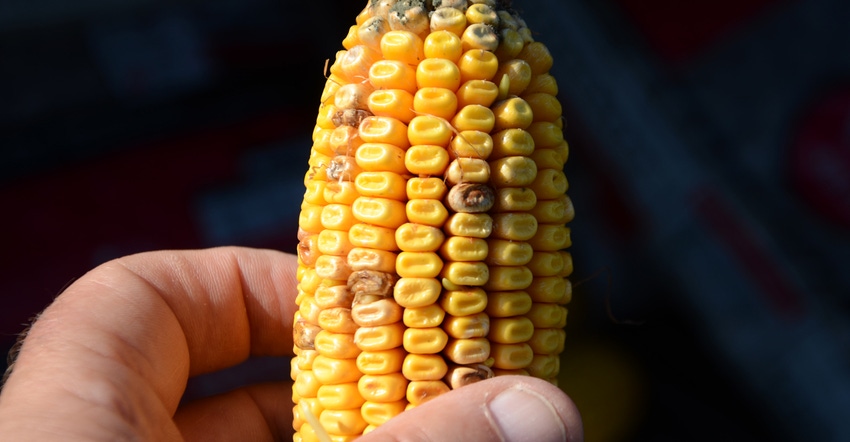
Whether your average corn yield for 2022 turns out above, below or at average depends heavily on summer rainfall patterns and temperature trends in your area. For the Corn Watch ’22 field in central Indiana, Dave Nanda says more than six weeks of extremely hot, very dry weather in June and July left the season on the brink. A return to more moderate temperatures with adequate rainfall in August rescued yield potential but brought baggage with it.
“The early yield report where end rows were harvested is encouraging, and we’re expecting a whole-field yield above 200 bushels per acre,” says Nanda, director of genetics for Seed Genetics Direct, sponsor of Corn Watch ’22.
Related: Leaf samples reveal multiple diseases
“While yield recovered, evidence of stress remained. Most ears were slightly shorter than in most years, with a few scattered kernels missing. There was tip abortion on some ears, although not much in better soils.
“The biggest signs of stress were ear molds, plus some sprouting and insect damage. The stressful season left its mark.”
One ear’s story
The ear pictured here is from a different field that was also monitored during the season. Steve Gauck, a regional agronomy manager for Beck’s, based near Greensburg, Ind., pulled this ear from an irrigated field bordering the Soybean Watch ’22 field. If you observe the ear carefully, it also helps explain the growing season, Gauck says.
Here are his observations. The ear is considerably shorter than normal, with just over 20 kernels per row. There was some pollination failure at the tip. There is also mold, perhaps two kinds: one at the tip and one on scattered kernels. Finally, a few kernels are sprouting, including one near the tip and a couple near the top of Gauck’s finger.
Short ear. An ear with 35 kernels per row, like those Nanda observed in the Corn Watch field, is “slightly short.” An ear with just over 20 kernels per row, like the one pictured, is seriously short. “The plant may have been affected by heat or drought stress when decisions on ear length were made,” Gauck says. “Part of it may be related to lack of sufficient nitrogen. Most ears were longer than this one, at 34 to 36 kernels per row, but walking the field near black layer, leaves were fired, indicating plants ran out of nitrogen.”
Pollination failure. Seeing some bare cob at the tip isn’t unusual, especially in a stress year, Gauck says. “In this case, it appears that most ovules near the tip weren’t fertilized,” he explains. “If they were fertilized and aborted later, there should be signs of kernels that formed but dried up. Even in irrigated fields, heat can affect pollination success.”
Moldy corn. Early-season heat stress and perhaps stress from lack of nitrogen late could have set up ears for mold. Types of molds on this ear weren’t confirmed, but gibberella and fusarium are likely suspects, Gauck says.
Sprouting kernels. Ears with sprouting kernels before harvest was a widespread complaint this fall. “It likely goes back to having lots of moisture late,” Gauck says. “Hybrids that naturally hold ears tighter at maturity are more suspect to sprouting.”
About the Author(s)
You May Also Like




